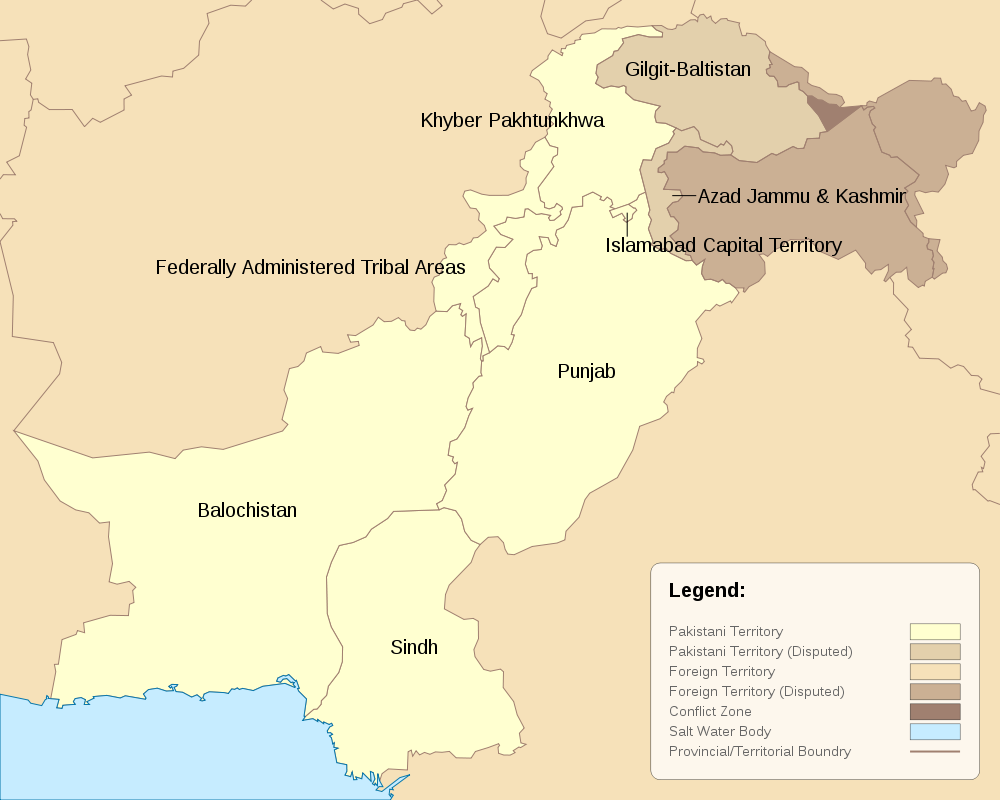 Episode 32 West and East Pakistan
Episode 32 West and East Pakistan
A History of India
Michael Fisher (2016)
Film Review
As of 2016 (when this lecture was recorded), Pakistan had experienced only one democratic transition between democratically elected governments.
In August 1947 when India and Pakistan declared independence, Pakistan’s first governor general (Muslim League Mohammad spokesperson Ali Jinnah) envisioned Pakistan as a secular state with religious freedom. Owing to his death from tuberculosis a year later, he was unsuccessful in fully implementing this vision. At present, Pakistan is officially a Sunni Islamic state. Its current federal Shariat court has the power to override any law that conflict with its interpretation of Islamic law.
Pakistan’s Main Provinces
- Punjab – had the largest population and was also Pakistan’s main agricultural area.
- Sindh – somewhat less important agriculturally, Sindh was dominated by the majority Urdu-speaking Muhajir community who moved from India to Sindh during partition. There they assumed ownership of wealthy Hindu lands following their expulsion during partition. Their community became the country’s first political and military hub. Its largest city Karachi became Pakistan’s first capitol.
- Bengal – there were were tensions between West and East Pakistan (aka Bengal province),* from the outset, especially after Jinnah declared Urdu (instead of their native Bengali) as the official language of East Pakistan.
- Balochistan – the largest region geographically with the richest mineral resources, including natural gas. It’s majority Baloch population has been in conflict with the Pakistani government for more than seven decades, in part because they receive no financial compensation for their rich resources and in part because Balochs in Afghanistan, Iran and Pakistan have been fighting for seven decades (with major support from the CIA*** and British and Indian intelligence) for their own autonomous region.
- Federally Administered Tribal Areas (FATA) – Pashtun speaking Pakhtuns straddling the border between Afghanistan and Pakistan are also seeking their own independent state. Historically FATA is outside Pakistani government control and govern themselves via Sharia law.
- Khyber Pakhtunkhwa – also self governing under Sharia law. According to Fisher, the Taliban, al Qaeda and ISIS all have a major presence there.
- Kashmir – currently disputed. Although Pakistan only controls one-third of Kashmir (Azad Kashmir), they claim the entire province owing to its large majority of Muslim residents.
Pakistan’s Heads of State
There were no direct national elections in Pakistan until 1958. The members of Pakistan’s first constituent assembly were originally elected to the Constituent Assembly of Undivided India and retained their posts following partition. Its members elected Liaquat Ali Khan Pakistan’s first prime minister, while George VI appointed Jinnah Pakistan’s first governor general.** As the constitution had yet to be written, Khan proclaimed Pakistan a Muslim society that protected minority religions. He was assassinated in 1951.
Following Khan’s assassination, Pakistan’s third governor general (Jinnah died of TB in 1948) Gulam Muhammad dismissed its Constituent Assembly and appointed himself Khan’s successor.
In 1955, Muhammad was forced out by Iskandar Ali Mirza, a retired general, who was subsequently appointed governor general by Elizabeth II. Following his implementation of Pakistan’s constitution, he was unanimously elected president by the new constituent assembly (elected indirectly by the main political parties, rather than popular vote). In 1958 he declared martial law and dismissed constitution assembly but was subsequently forced into exile by General Ayub Khan, who went on to rule Pakistan as a military dictatorship for the next 11 years.
In 1961, Khan wrote a second constitution that concentrated wealth in the hands of the elite, gave the army greater supervisory authority over government and moved the capitol to a new planned city called Islamabad. Khan also entered into a military treat with the US, under which Pakistan provided bases for U2 spy planes. In 1965, he declared war against India (over Kashmir) with US equipment against Soviet-equipped India.
Pakistan’s failure to win control over Kashmir, as well as worsening economic conditions, led to increased popular unrest and a second military coup in 1969. General Yahya Khan become president, suspended the constitution and the judicial branch of government and dissolved the constituent assembly.
The single civilian he brought into cabinet Zulfikar Ali Bhutto (who had studied in the US and at Oxford). Bhutto, who went on to create the Pakistani Peoples Party, was elected president in Pakistan’s first popular election in 1970. His party won all the seats in West Pakistan, and no seats in East Pakistan. Because East Pakistan had a much larger population, their candidate Sheikh Mujibur Rahman of the Awami League won the most votes overall.
After nullifying the election and dismissing the constituent assembly, Khan dispatched the Pakistani army to “restore order” in East Pakistan. In Operation Searchlight he arrested and killed large numbers of Awami League activists, while 10 million fled as refugees into India.
India would help organize the male refugees into Mukti Bahini to wage guerilla warfare against the Pakistani army. Together with the Indian army, they captured the entire Pakistani army posted to East Pakistan (100,000 troops), enabling the province to declare independence as Bangladesh.
Following Khan’s disgrace in East Pakistan, Buttho set him aside to make himself martial law administrator prior to being elected president in 1971.
*East Pakistan became Bangladesh in 1971.
**As a dominion in the British Commonwealth of Nations, Pakistan views the British monarch as their sovereign, and all laws passed by the Parliament must receive royal assent (via the British-appointed governor general).
***The US goal was to increase their control over the Middle East and South Asia (as they did Yugoslavia). The map below was originally published in the Armed Forces journal in an article entitled Blood borders: How a better Middle East would look.
Film can be viewed free with a library card on Kanopy.

Pingback: Pakistan’s Long History of Military Coups | The Most Revolutionary Act